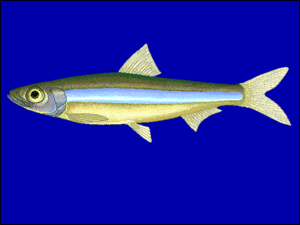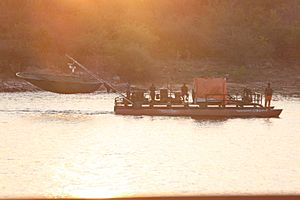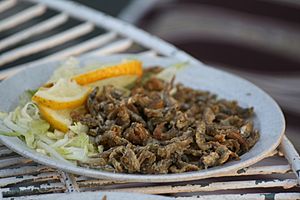Kapenta facts for kids
The Tanganyika sardine is a small fish known as kapenta or matemba in countries like Zambia, Malawi, and Zimbabwe. There are two main types of kapenta: the Lake Tanganyika sardine (Limnothrissa miodon) and the Lake Tanganyika sprat (Stolothrissa tanganicae). Both are small, freshwater fish that eat tiny plants and animals (called plankton) and live in the open waters of Lake Tanganyika. They are a very important part of the fish population in Lake Tanganyika and Lake Malawi. They swim in large groups, called schools.
Limnothrissa miodon usually grows to about 10 cm long, but can reach up to 17 cm. Stolothrissa tanganicae is smaller, typically 7 cm long, with a maximum of 10 cm. Kapenta has also been successfully introduced into other lakes in Africa, like Lake Kariba (between Zambia and Zimbabwe) and Cahora Bassa in Mozambique.
Catching Kapenta
Kapenta fish are usually caught at night. Fishermen use special boats called kapenta rigs. These rigs have bright LED lights or kerosene lamps. The lights attract the fish to the rig. Then, a large net is used to scoop the fish up. This net can be about six metres wide and 8 to 10 metres long. It can reach down to depths of 40 metres (130 ft) to bring the fish to the surface.
Keeping Kapenta Populations Healthy
In recent years, the number of kapenta fish has been going down. To help keep the kapenta population strong, some countries have made rules. For example, it is now against the law to fish for kapenta in shallow water (less than 20 metres deep). This is because kapenta fish lay their eggs and reproduce in these shallow areas. Countries have also started using special fishing permits or licences. These help control and keep track of how much fish is being caught.
Kapenta as Food
Kapenta is a very important food source in Africa. It provides protein without needing a refrigerator. A small cup of dried kapenta can feed a whole family.
Most kapenta is dried in the sun. Fishermen spread the fish on clean surfaces like concrete, rocks, or special drying racks. Drying on racks usually gives the best results. It takes a day or more, depending on the weather. Sometimes, the kapenta fishing season happens during the rainy season. This makes sun-drying difficult. If the fish cannot dry properly, it might not be as good quality. This means it sells for a lower price. Sometimes, poor quality dried fish is even used as chicken feed.
To help with drying, kapenta can be salted first. About 2.5 kg of salt is used for every 30 kg of fish. Then, it is dried in the hot sun.
In Zimbabwe, dried kapenta is often cooked by frying it lightly with onions, tomatoes, and groundnut powder. It is usually eaten with a traditional meal called isitshwala or sadza.
Fresh kapenta is also popular. It is packed in plastic bags and frozen. Frozen kapenta is more expensive than dried kapenta. You usually only find fresh kapenta for sale in fishing villages.
Kapenta is also an important bait fish for the African tigerfish. Even though kapenta was brought to lakes like Kariba and Cahora Bassa, it does not seem to have harmed the environment there. Kapenta fishing helps the economies of the areas where it is caught.
Images for kids









